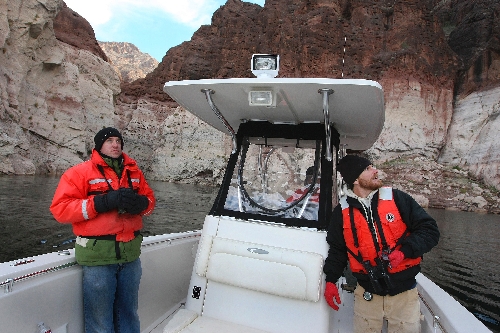Survey: Eagles flying high at Lake Mead
Bald eagles are back soaring in record numbers at Lake Mead National Recreation Area, four years after the once-imperiled, iconic bird of prey was taken off the nation's list of endangered species.
During their annual winter survey Thursday, wildlife biologists from the National Park Service, UNLV's Public Lands Institute and other state and federal agencies counted 176 bald eagles along the shorelines of lakes Mead and Mohave.
The tally is a preliminary number based on initial data from the survey routes. It tops last year's total and previous record of 163 by 13 eagles.
In all, biologists with the help of 44 volunteers observed 183 eagles, counting five golden eagles and two that were listed as "unknown," from boats on the eight survey routes.
"It appears they're holding their ground," said Dawn Fletcher, a wildlife research assistant at the Public Lands Institute, who said she is "very happy" with the results.
"As far as what it means for the overall population, it's hard to say because we don't know what's going on regionally."
Bald eagles could be converging on the lakes that straddle Southern Nevada and Arizona because they hold a plentiful supply of fish -- primarily striped bass, trout, gizzard shad and carp. They also have been known to feast on waterfowl, such as coot, after their distant migrations.
Fletcher said it's possible that bald eagle numbers have increased at lakes Mead and Mohave because they've moved from some other places that have less available food.
Since bald eagles were delisted in 2007, biologists have noticed that an increasing number of bald eagles are making lakes Mead and Mohave their winter destination and not just a place to rest during their migrations from the Pacific Northwest and Canada.
For the first time in a three-decade span of conducting annual counts, biologists confirmed that a nesting pair stayed year-round in a remote part of the sprawling Lake Mead National Recreation Area.
"That was a significant event," said Joe Barnes, a wildlife biologist with the Public Lands Institute.
"Two years ago the male moved in. Then he got a mate and she laid eggs last year," Barnes said Thursday while leading the count on the Boulder Canyon route. "They're still around. It's exciting for the park."
The Boulder Canyon route, which includes the southern part of Lake Mead's Overton Arm, turned up 31 eagles during the dawn-to-dusk count, five more than last year.
They were seen flying across an azure sky below wispy clouds. Many stood like stumps or fire hydrants, perched high atop cliffs and along rocky shores of places with names Rufus Cove, Gordy's Cove, Boulder Point and Jim Jones Reef.
A variety of wildlife was observed including big horn sheep, burros, mallards, grebes, mergansers, loons, great blue herons, red-tailed hawks and a peregrine falcon.
Most important for the survey was the increase in bald eagles, including adults and immature birds that were about even in numbers on the Boulder Canyon route and for the entire survey.
Young eagles have a mottled appearance compared with the distinct snowy white hoods and tails of adult bald eagles, which have brownish-black bodies and 6-foot wing spans.
"If you go back to when they were endangered, they were pretty imperiled for a while," Barnes said.
Only 60 bald eagles were counted during surveys on the lakes in 2001 and 2004, which, like this year, were part of midwinter surveys conducted nationwide by the National Park Service and the U.S. Geological Survey.
Eagle surveys in Lake Mead National Recreation Area date to the early 1980s, but the count method was standardized in 2001 and revised in 2007 to improve the quality of the data.
The bald eagle was declared an endangered species for much of the United States in 1967, before passage of the Endangered Species Act of 1973. Only 417 nesting pairs were known to exist in the contiguous 48 states in 1963.
The bald eagle's demise was blamed in part on habitat loss. But pesticides that have since been banned played a role by contaminating prey the eagles ate, causing egg shells to thin and making adults sick and infertile.
While the law requires that the nation's bald eagle population be monitored for five years after delisting, Fletcher said she hopes the annual surveys will continue beyond 2012.
"It's important to keep it going, because we couldn't possibly see if their numbers go down," she said.
Contact reporter Keith Rogers at krogers@reviewjournal.com or 702-383-0308.































